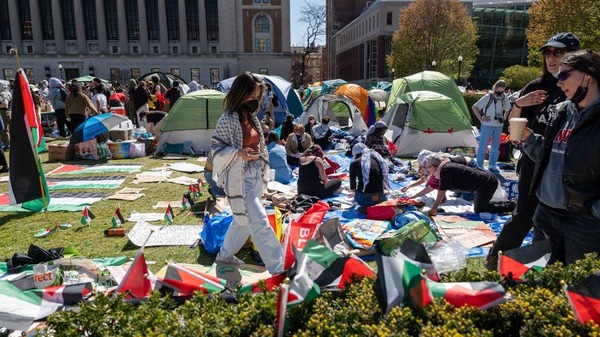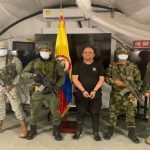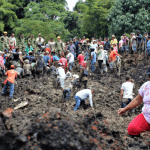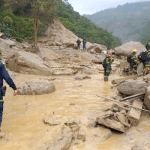Gaza war protesters have vowed to remain at Columbia University until their demands are met, despite mass arrests and disciplinary action.
More than 100 students were arrested at a Columbia protest encampment last week, followed by dozens more at Yale and New York University in recent days.
Many at Columbia have been suspended, prompting vocal calls for disciplinary measures to be dropped or rescinded.
Some students on campus have reported antisemitic harassment from protesters.
A deadline that was given by the university on Tuesday for protesters to disband by midnight has now been extended by 48 hours, with officials reporting “important progress” in talks to reach a deal.
Columbia president Dr Nemat Shafik earlier warned that without an agreement, she would have to consider “alternative options” for clearing the encampments before term ends on 6 May, ahead of graduation ceremonies later in the month.
Columbia’s campus was calm on Tuesday afternoon as hundreds of activists continued to occupy tents on the university’s lawn.
The entire area was adorned by dozens of Palestinian flags and placards with slogans such as “real Americans stand with Gaza”, “demilitarise education” and “there are no universities left in Gaza”, set against a constant soundtrack of “free Palestine” chants and drumming.
Inside the camp, volunteers distributed donated supplies and held assemblies in which the latest news from Gaza was shared.
Similar encampments have sprung up at universities across the US, including the University of California – Berkeley, Yale, Emerson and the University of Michigan.
Since last week, protesters at Columbia – partly organised by a group called Columbia University Apartheid Divest (CUAD) – have called on the university to fully divest its finances, including its endowment, from companies and institutions it claims profit from Israel’s “occupation” of Palestinians.
A committee that advises the university on socially responsible investing rejected these demands earlier this year, saying there was a lack of consensus in the Columbia community over the issue.
CUAD also calls on the university to cut links with Israeli institutions such as Tel Aviv University, to formally call for a ceasefire in Gaza, to end policing on campus and to “sever ties” with New York police.
In the wake of last week’s arrests, another demand was added: amnesty for protesters who are facing disciplinary action from the university. Some have lost their meal plans and housing, forcing them to find alternative accommodation.
Another participant, a 2016 graduate who asked to be identified as Iralisa, returned to her alma mater for the demonstration. She said the group was “determined to remain” until their demands were met.
The ongoing protests, however, have been marred by allegations that Jewish students and faculty members have been subjected to antisemitic abuse. Those concerns prompted the university to extend remote learning to the end of the semester.
One video posted to social media by a Hasidic group, Chabad, appears to show Jewish students being subject to a torrent of verbal abuse.
The incidents have also attracted the attention of some US lawmakers such as New York Republican Elise Stefanik, who warned that an “unsanctioned mob” had created “an environment that is unsafe for Jewish students and faculty.”
Earlier in the week, a rabbi associated with Columbia also sent a message to Jewish students, warning them to “return home” until the situation “dramatically improves”.
Many of the demonstrators downplayed concerns about antisemitism at the protests. In interviews, they argued that incidents of harassment of Jewish students had been rare and blown out of proportion by those opposed to their demands.
One protester, Soph Askanase, a 21-year-old junior from Barnard, Columbia’s sister college, contested the idea that the campus had become unsafe for Jewish students like her.
Marianne Hirsch, a professor of literature who also specialises in Holocaust studies, said that while there have “certainly been incidents” of antisemitism at Columbia, she feared that the issue was being “weaponised and misused under the guise of safety and security.”
This was “actually cutting down on the academic freedom to be critical,” she argued. “Bringing armed police onto campus creates an atmosphere of fear and intimidation. That’s not what this university is about.”
In a news conference on Tuesday, New York City Mayor Eric Adams and top police officials blamed “outside agitators” for stirring up protests at Columbia and New York University and “really trying to use this as an opportunity to cause violence in our city.”
Dr Shafik, for her part, has specifically blamed “outside protesters” for “producing much of the incendiary language that is causing deep distress for many”.
Parallel protests have emerged on the fringes of Columbia’s campus, including one that attracted several dozen vocal participants two blocks away on Tuesday.
Some student organisers have distanced themselves from the outside demonstrations, even if they agree broadly with their intentions.
Some students – even those uninvolved in the protests – directly blamed Dr Shafik for stoking tensions on campus through her decision to call in police to clear the campsite last week.
Several protest leaders told reporters that they had held negotiations and discussions with school officials, although they declined to give further details.
Some have already claimed victory, even as the protests grind on.














